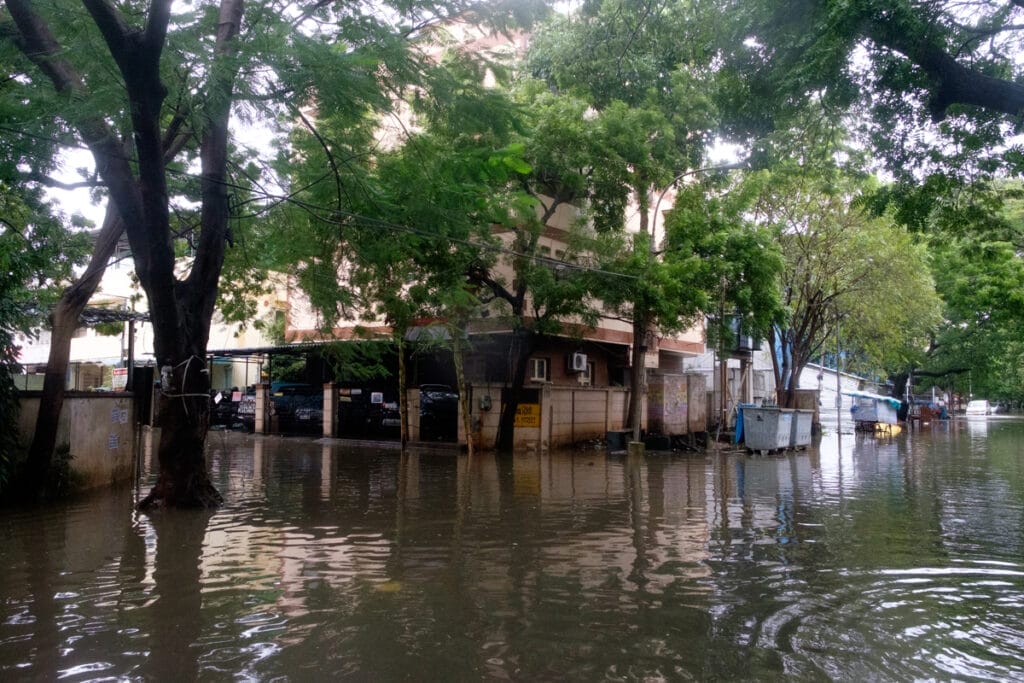Whenever rainstorms hit and the Adyar River swells, the residents living beneath the Saidapet Bridge hold their breath, silently praying for reprieve. The haunting memories of the catastrophic 2015 floods, when the river overflowed and submerged the bridge, still linger. Many homes were inundated and belongings were swept away, leaving a lasting impact on the community.
This happened again during the December 2023 floods. That’s why, residents here live in constant fear. On Saturday, as Cyclone Fengal brought severe thunderstorms and gusty winds over Chennai, they just clung to hope that the flood waters would not reach their homes.
Read more: Calm after the storm in Chennai: What Cyclone Michaung left behind
As the cyclone crossed the coast near Puducherry on Saturday, torrential rains brought life to a standstill in Chennai. Meanwhile, flight operations from the Chennai International Airport and suburban rail services were suspended till Sunday morning. The city experienced gusty winds with wind speeds of up to 70 kmph.


From Vyasarpadi, Perambur and Kodungaiyur to Velachery, Taramani and Ashokanagar, many areas face waterlogging issues, while marginalised communities are the worst hit. So, here are glimpses from the city struggling to cope with the cyclone.


Lack of preparedness
By Sunday morning, the rain had stopped in most areas, yet many localities remained waterlogged. Although the devastation is not as severe as that caused by Cyclone Michaung last December, and the water receded more quickly this time, many residents cite poor governance by urban local bodies and the Tamil Nadu government. “Total neglect of the water bodies in the city, is the reason for the inundation. As the lakes are not maintained, excess water causes flooding of nearby areas,” says S M Govindarajan, Founder President, United Federation of Residents’ Welfare Associations at Tambaram City Corporation.
He mentions that excess water discharged from Rajapakilpakkam Lake was let out at Gokul Nagar 3rd Street in Tambaram and few houses in the locality were inundated.
Overflowing stormwater drains

Storm water drains are also seen overflowing in many areas of Velachery and Taramani, as they are not able to hold the rainwater. But, in few areas like Kalakshetra Colony in South Chennai, water receded quickly. “That’s because GCC carried out desilting of SWDs and RWH pits and the residents’ association supervised the work earlier this year. Also, two trees fell at the junction of Beach Road and Tiger Varadachari Road on Saturday, which workers from the park division cleared quickly,” says Krithiga Viswanathan, member of Kalakshetra Colony Welfare Association.




Cyclone Fengal is the second cyclone to develop over the Bay of Bengal this season. Despite the government’s promises of preparedness, Chennai residents face hardships every year during heavy rains. Will the authorities address these issues and bring relief to Chennaiites?
As a resident of 18th Avenue Ashok Nagar, I am at a loss to express myself – whether I should be happy that our area is in the news and limelight every monsoon or sad over the plight. SWD completed but solution is still far away. Pondering whether SWD stands for Storm water Drain or Solution without Destination.